Monday, May 21st, 2018
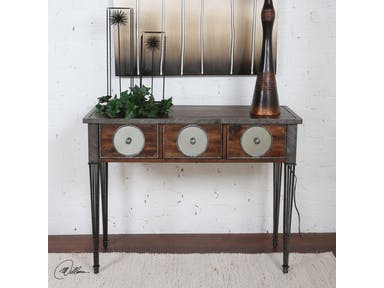
Uttermost Living Room Patten Distressed Walnut Console Table 25977
If you fancy using materials such as rough wood, metals, and brick; and if you love the idea of exposed structural elements or even the use of ladders as a bookcase, then you would probably embrace the concept of urban interior design.
Also known as Industrial interior design, this is a style that does not require any cosmetic tricks. Today, we’re aiming the spotlight at this particular style.
Urban Style and Its Humble Beginning
There isn’t a lot of information about the origin of urban interior design. It is assumed that it was developed during the early part of the 20th century. By the time that the second industrial revolution ended, this trend has already captured the world. Decades after, the style became even more globalized.
What spurred all these were the Western European factories which started to close down. They then moved their business to low-cost nations. This resulted in vacant buildings and neglected warehouses.
These plants were suitable for what are now known to be residential conversions. Through the years, cities became quite popular with such renovations. And with the lack of space that is often associated with urban living, it has become a fight-for-living-space of sorts out there. The transformation of the old industrial structures has become the most logical solution.
And with more and more people moving into such buildings, it soon became apparent that they did not even try to conceal the bare walls, large window panes, and the rough cement. As a result, urban interior design or what’s known more popularly as industrial interior design was born.
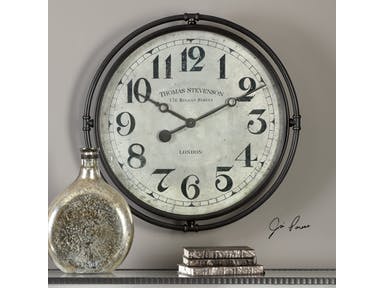
The Uttermost Accessories Nakul Industrial Wall Clock 06449 has ‘aged’ features which makes it the perfect decorative feature to those bare concrete wall.
Urban Style Elements
Each interior design comes with specific characteristics. For instance, when you want to use the Nordic interior design, you should be prepared to use light colors and just natural materials. The urban interior design is just the opposite.
First, there are rough brick walls. No need to hide them or do cosmetic applications. In many cases, the focus is more on the bare structure even un-plastered walls. These elements create a cozier and warmer ambiance.
Other elements that you can use include wood and concrete floors. Homeowners often pick a concrete floor more than the wooden option, though.
A third option that you can take is to have an open ceiling. This element must also be left bare. Emphasize the concrete columns, beams, and steel girders. If the ventilation pipes are exposed then let them be. You can paint the ceiling black so you can add depth to your surroundings.
A fourth design element that you might want to include are huge steel windows. These can give your space a retro look because of the small panes. What’s great about these is that more natural light can stream in.
Urban interior design is all about having an open space layout. To have visual divisions, you can use wooden screens and cabinets.
Leather seats are also a wonderful addition to an industrial design home. Dark furniture is the best choice while bright-colored pieces are a no-no. Those that show a bit of wear and tear may also be added as are metal lockers and such.
When it comes to décor, be sure to pare down your options. You will not see a lot of plants, pots, and figurines. In this home, less is definitely more.
Steel stairs can also add to the openness of the area. The types that have a simple landing and railings are a wonderful option.
Lastly, you should consider adding industrial lighting since this is a must in any urban style dwelling. You can have the pulley-inspired types or even the scissor accordion lights that you can use on the walls. The beauty of this kind of lighting is that you can fuse contemporary styles with the older structural features.
Tags: industrial interior design, industrial interiors, McCreerys, McCreerys Home Furnishings, urban interior design, urban style
Posted in Interior Design 101, Interior Design Elements, Interior Design Themes, Lighting | Comments Off on Urban or Industrial Style – And How to Make It Become You
Friday, April 20th, 2018

Accessorize with this industrial Uttermost Accessories Nakul Industrial Wall Clock 06449.
Industrial design rooted from the need to have safety and efficiency in terms of architecture. Just recently, this style has become iconic insomuch that people rushed to search for old buildings such as warehouses and factories. This sudden demand for industrial spaces welcomed the trend for industrial chic.
The first industrial structures, these days, are many sought-after locations for weddings, company events, and other such occasions. These structures were, of course, originally meant to protect workers and house machines. Yet people are not deterred by the aging columns, distressed walls, and old pipes; each buyer seems to be able to see the stories that are represented by the imperfect buildings.
A Short History
The late 1700s were the years when the first industrial structures were built. These were meant to be utilized as working structures. But with the advances in electricity, engineering, and architecture, these have long since been used for more than their utilitarian value.
Industrial structures originally have zero frills. These were, after all, buildings that are supposed to facilitate work. Fear of fire became prevalent during those years, too, that flat roofs were recommended and owners were discouraged from constructing attics.
This unfinished, raw look is what now characterizes the beautiful industrial chic homes of our time. Exposed bricks, ductwork, and pipes are all but common features in industrial chic homes.
By the 1900s, bigger spaces were needed because of the advent of new energy sources. Steel and concrete then became the new go-to materials for industrial buildings. These structures are now more in line with what you see as an industrial home today.
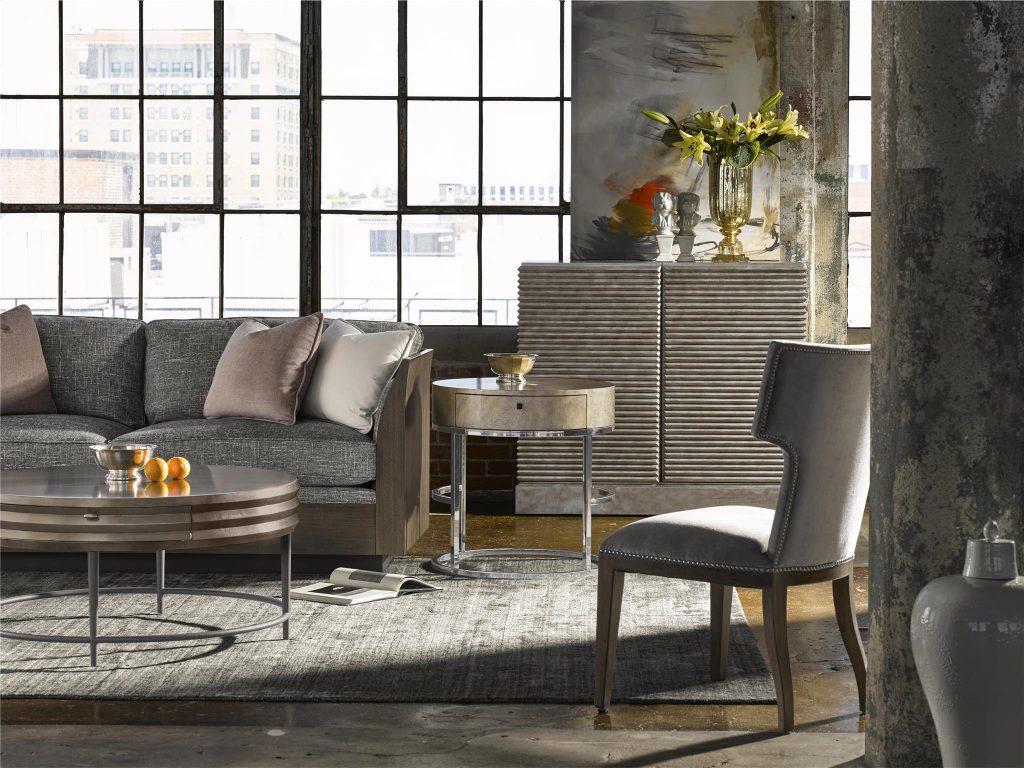
Fine Furniture Design’s Cachet Collection sits perfectly in this industrial building.
Old Factories, New Homes
Majority of industrial buildings have no walls to block natural light. These are, therefore, easily repurposed as Lower Manhattan and New England homes. It was during the late ‘60s and ‘70s when these spaces were renewed and were reclaimed by artists due to their abundant lighting.
Interior designers have long since caught up. They have successfully glamorized industrial chic because of its renewing and reusing characteristics. The defining features of such homes are now the open lofts as well as the exposed structural details.
Industrial chic is one of the few designs that can perfectly blend with any style. It can be traditional, modern, rustic or elegant. Industrial chic is not cold but neither is it too warm. This is the right style that effortlessly strikes a balance.
Remember to include elements such as metal, bricks, and reclaimed wood in your industrial chic home. The very building which your home is was made to celebrate perfect lighting, open floor layout, and accommodate large social hubs.
Industrial chic can also be masculine once the steel, concrete, and bricks are not softened. The steady rise in industrial chic space demands has risen up with the ever-rising concerns for gender neutrality. It is now easy to see neutral elements such as Edison bulbs, reclaimed wood flooring, ceremony altars, factory windows, and doors.
Other Industrial Chic Key Traits
Industrial chic is all about proudly displaying the building materials that were used to construct the building. Loft apartments, commercial spaces, and modern homes make use of these past utilitarian spaces.
The warehouse look proudly shows the exposed ducts and pipes and other such raw elements. It is also common to see metals on walls as a feature of an industrial chic home. Those who long for this look may also incorporate metallic furnishings. Polished metals as shelves, as well as feature metal brackets, are features that you can also use.
It is also okay to combine metal with wood surfaces. You can see a plethora of this fusion throughout the more subtle industrial chic homes.
Tags: industrial, industrial chic, industrial design, industrial interior design, industrial structures, industrial style, McCreerys, McCreerys Home Furnishings
Posted in Interior Design 101, Interior Design Elements, Interior Design Themes | Comments Off on From Building to Industrial Chic Home
Wednesday, March 21st, 2018
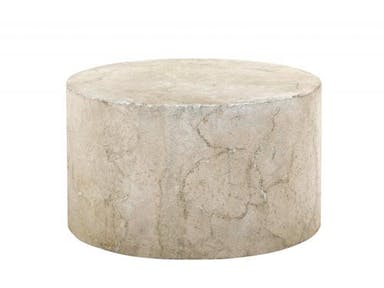
The Bernhardt Interiors Living Room Cocktail Table is concrete and is ‘texturally’ beautiful.
When you’re asked to consider concrete as a design element in a home, you might become hesitant because this is a material used on pavements and the very foundations of homes. However, more and more interior designers are looking to this material as an awesome way to beautify a home. It actually offers various stylish looks that stand out from the rest.
Sure, concrete could look a bit on the rough side but this ruggedness can also be subdued to appear warmer and even cozy. If you were to learn some guidelines in effectively using concrete as a design element, would you be willing to consider it for your home?
A Great Medium
Concrete can be a great medium especially when you live in a home that’s almost entirely made of wood. Adding concrete would offset the too organized or formal look that wood offers. When choosing concrete, make sure that you pick a supplier that will provide one with the best quality.
For this year, 2018, you might have noticed that the design trends aren’t exactly absolute. In fact, they tend to be polarized as the colors are bold although, aesthetically, the more neutral elements are also still utilized.
Such is the look that is being offered by concrete. It is subtle, it is not as jolting as this year’s Pantone Color of the Year but it is, nevertheless, a stylish element that can give any design element a good fight.
The Industrial Edge
Concrete is synonymous with the industrial interior design. No other element epitomizes the beauty of this style more than this material. Just imagine the old warehouses and industrial buildings from decades ago and you are already conjuring a picture of a concrete-themed home.
Other elements that make the industrial design unique are the reclaimed types of machinery as well as other metallic accent pieces. Add an exposed steel or wooden beam here and there and you’ve just created the basic look for an industrial home.
If you want to know where to begin with the industrial look, then go for concrete floors. These are the natural choice more particularly for homes with rustic exposed wood.

Here, the concrete floor is made cozier by the placement of an area rug. Featured here is the Brentwood Collection from Fine Furniture Design.
Concrete Is Texture
Visual and tactile texture can add amazing amounts of interest into any space. Talking on the level of an interior designer, texture is an element that allows you to feel even when you’re just looking. While you do know the feeling of running your hands over rough or smooth concrete, looking at it is a totally different thing. Using concrete, in a way, is adding interest to a neutral room.
Create contrast with your concrete element. Its primary contrasting element is always wood. Pay attention also to the hues that are used on concrete. Use shades that contrast with the rest of the space.
Use as a Focal Piece
No space works without a focal point or two. Concrete is a heavy element that’s used in design. Technically, it already takes on the majority of the visual weight in any space. This means that the eye of the beholder will automatically be drawn towards the concrete element used.
This only means that concrete is an amazing option for a focal point. Again, imagine a fireplace made of concrete. This is a bold architectural feature in any living room that does not even try hard to be noticed.
A concrete kitchen island also becomes an instant conversation piece. A concrete coffee table, on the other hand, serves as the anchor in a seating zone.
Concrete is not bold, bright or even patterned in its most basic form. It is subtle yet, somehow, it is the ultimate winner in terms of visual attention so you would never go wrong to use this element to design your space.
Tags: concrete, concrete interiors, industrial design, industrial interior design, industrial interiors, McCreerys, McCreerys Home Furnishings
Posted in 2018 Trends, Interior Design 101, Interior Design Elements, Interior Design Themes | Comments Off on Concrete – The Best Theme for 2018?
Friday, October 27th, 2017
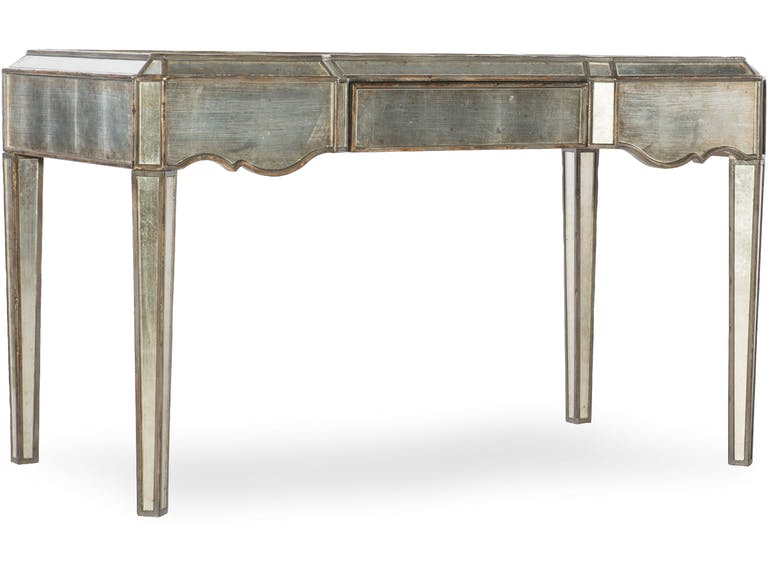
Hooker Furniture Home Office Arabella Mirrored Writing Desk
Industrial interior design is all about displaying the raw building materials, it’s about the non-concealment of pipes, wood beams, trusses, rough concrete, and metallic surfaces. It is also being proud of the unfinished look that is offered by this functional yet still stylish design.
What you achieve is a warehouse look of sorts though this can also be polished into a more sophisticated space.
If you have been perusing interior design magazines lately, you would be able to see that there are many designers who are now incorporating the industrial look to their other designs. Many stylish homes now have stainless steel features, vintage-looking furniture pieces, and metal lighting fixtures. If you want to get the look, too, here are some tips –
Expose ‘Em
A signature element of any industrial space is its ducts and pipes. Warehouse apartments are now the in thing to beat. They are everywhere and everyone seems to want to live in one. In fact, old factories and office spaces are being converted into residential living spaces.
Of course, the alteration can be challenging but the homeowners who eventually move into these spaces find great joy with their decision.
All white spaces are the perfect backdrop for exposed pipes. The brightness of those white walls and ceilings provide the needed contrast to the piping system.
Use Metals Everywhere
Apart from the ducts and pipes that remain exposed, another feature of industrial homes is the presence of metal paint on doors or metallic sheets on walls or vice versa. Industrial kitchens look amazing with their glimmering metallic surfaces from the stoves to the refrigerator, even down to the handles of cabinets.
The best way to approach designing with metal is to do it subtly. You could begin with the simple elements such as metal bowls or vases. You can even group these together to form a more dramatic statement.
Metal frames also bring in positive Feng Shui. Find frames that have the same finishes and not contrasting ones.
And Then There’s Wood
Industrial interiors also offer a wonderful vision of wood combined with metal. Earth tones or neutrals are common color schemes for industrial homes. The textural fusion of smooth, shiny metals plus the grainy and earthy look of wood is just an amazing thing to behold. This is the perfect juxtaposition of the raw plus the refined, respectively.
Many even choose glossy metals or chrome accents in their kitchens as well as lighting fixtures. If you began with chrome, then go for chrome throughout. Know how to mix metals and the number one rule is to find a dominant metal to use. While you can still mix cool with warm metal tones, having gold as the dominant hue, then let gold prevail.
Use the Open Concept
Industrial interior design takes the open space concept to a whole new level. The furnishings are the defining pieces for most spaces. Since the pieces are limited, the homeowner has to take time to think of even the tiniest details.
Those who are thinking of renovating to turn their home into an industrial space should create a mood board. Pin as many inspirations as you can on this board before actually embarking on this change.
Pick Industrial Colors
Are there really colors that do not agree with the industrial design?
Typically, the hues that are used are neutral, warm colors because they help bring out warmth into the already cold space. Remember that the ducts and pipes are cool elements so it pays to balance them by putting in lots and lots of brown, taupe, and certain shades of red.
Tags: industrial design, industrial design elements, industrial interior design, industrial interiors, industrial lighting, industrial look, industrial style, McCreerys, McCreerys Home Furnishings
Posted in Interior Design 101, Interior Design Elements, Interior Design Themes | Comments Off on Lovin’ the Raw Appeal of Industrial Interiors
Tuesday, April 18th, 2017
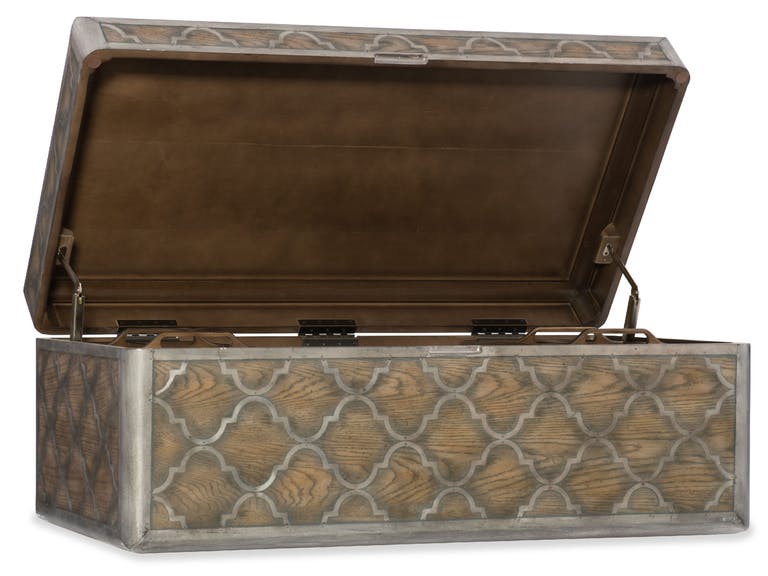
Hooker Furniture Living Room Arabella Trunk Cocktail Table
Industrial architecture is known for its safety and efficiency. Industrial style is always functional, even iconic. Industrial homes were once factories abandoned warehouses and huge open structures. Since these buildings were originally meant to house many people and huge machineries, they are tough and secure.
These industrial structures have a rich history to offer even with their distressed walls, worn flooring, and aged pipes. These may appear like scars to the eyes of their beholder but they can be highlighted to stress the industrialist appeal of the structure.
Industrial Architecture History
The primary industrial buildings were constructed in the late 1700s. These were supposed to be utilitarian and since there was no electricity then, narrow structures were built with large windows so that natural light could stream in.
Minus the common frills of homes of today, these structures were built to facilitate production. The manufacturing process was housed in a single place which led to faster processing and production streamlining.
Still in the 1700’s, safety issues began to be noticed. Mill factories were especially problematic. The fear of fire was widespread insomuch that buildings were built to reduce such dangers. It was also because of this that industrial architecture was starting to be influenced by insurance companies. Attics were discouraged and, in their place, flat roofs were made.
Flat roofs became the staple features. Along with these, plain facades, isolated stairwells, open spaces, ornamental pieces, pipes, and exposed bricks have become the iconic looks of industrial design.
In the 1900s, manufacturing became more robust because of the advent of fuel from regular coal. Mechanical power became available inside these factories, hence, there was a demand for more adaptable spaces and more modern construction.
Steel and concrete also entered the picture during these times. Albert Khan was the visionary architect who worked with these durable materials in his architectural designs.
Industrial design changed for the better and the looks of buildings have become the structures that we know them today. Steel and reinforced concrete made sturdier structures. The bigger, newer buildings then required bigger parcels of land. This led to the factories being built outside of cities and the metropolitan zones, hence, more and more structures were being uninhabited.
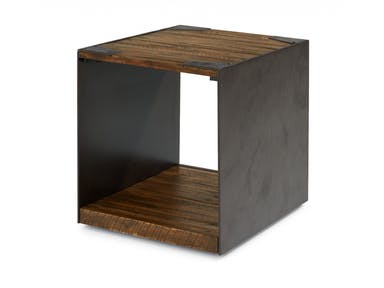
Flexsteel Living Room End Table W1404-01
Resurrecting Old Factories
With very few to zero walls, blocking natural lighting, these abandoned factories were viewed as the perfect structures that can be repurposed. The late ‘60s and ‘70s brought about the renewal of these spaces. The changes began in Lower Manhattan and in New England.
Initially, these structures became the home and studios for artists and their masterpieces. These people received a different kind of inspiration inside these buildings. Magazines even began to glamorize industrial chic. Recycling and renewal also became the in things to do.
Industrial Design Today
It is no surprise that weddings and other such celebrations are now being held in old industrial spaces. With huge windows allowing natural light to stream in, it is the perfect lighting for such lovely events. Even the huge, spacious walls seem like canvas to any work of art.
Industrial design is brimming with masculinity, what with the presence of brick, steel and concrete. Since this is so, they are the perfect elements to contrast the femininity of weddings.
It isn’t just the events industry that has opened its doors for the use of these industrial spaces. There are more and more homeowners who are signing up for these probable homes.
Industrial design, in a nutshell, is all about using etched glass, worn wood, rough metal and everything utilitarian. It is a traditional style that is simple and comfortable, in essence, the archenemy of slick.
So, are you ready to own or build one of these industrial structures?
Tags: industrial design, industrial interior design, industrial style, McCreerys, McCreerys Home Furnishings
Posted in Interior Design 101, Interior Design Themes | Comments Off on Industrial Design: Its Roots, Characteristics and Why It’s For You
Tuesday, December 13th, 2016
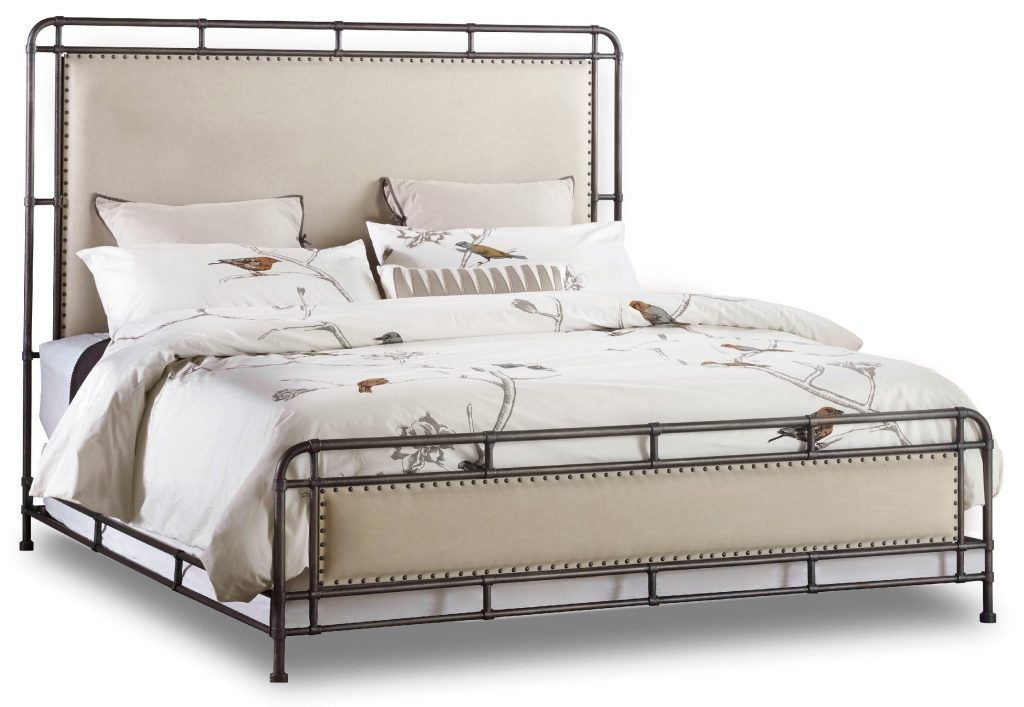
Hooker Furniture Bedroom Studio 7H Slumbr Queen Metal Upholstered Bed
Industrial design is one of those home styles that require you to be brave. It is not common, it displays the building materials which many homeowners try their best to conceal. It is also about adding unfinished and raw design elements to add a different kind of style.
Industrial design is a growing trend. It showcases utilitarian stuff, neutral tones, wooden and metal surfaces. What you achieve at the end of the day is a warehouse look that fuses an industrial feel with some earthy, polished elements.
Don’t get the idea that industrial design is just for unfinished spaces. Many design enthusiasts, these days, even incorporate industrial design to their upscale habitats by showcasing metal light fixtures, stainless steel surface, and vintage-looking furniture pieces. McCreery’s Home Furnishings offers excellent, thoughtfully-designed industrial pieces – http://www.mccreerys.com/itembrowser.aspx?action=attributes&ItemType=Furniture&event=reset&wcsearch=INDUSTRIAL.
Industrial Design Signature Elements
One of the leading signature elements of industrial design are exposed ducts and pipes. Warehouse apartments became quite popular in the past few years that many homeowners followed suit. Even former factories and other industrial spaces have been converted to residences.
Another element of industrial design is wood and its usual partner – metallic surfaces. It’s a small wonder that neutrals and earth tones are the most common color options for such homes. You can find an abundance of metal on staircases, ceilings and windows. Note also the wooden panels on ceilings.
Industrial design also means you have to draw some inspiration from anything that’s unconventional. Mix different rules and looks of interior design. This means it’s normal to find Boho or Mid-Century modern elements inside an industrial modern home.
Check out also the furnishings meant for rugged steam punk or contemporary chic styles. If these don’t tickle your fancy, then pick rustic colors to play safe. Select the color palette that connects your furniture, rugs, lighting and accents.
If your industrial home happens to have brick walls – whether painted or unpainted – cement flooring or wood, then you have practically achieved half of the look that’s required for this style. Rustic elements in industrial design feature a lot of beiges and browns. Remember that your chairs, sofas, tables and accessories would likely be made of raw wood and leather.
Burnt orange is also a typical color.
Industrial furniture pieces rely heavily on unfinished wood, so, if you’re planning on investing in a dining table, end table or a coffee table, it is best to find those made of raw wood. This should help you achieve that genuine industrial look. While the tables can be made of wood, you can also make use of exposed steel legs and such features.
Another trend that’s gaining popularity lately is reinforced concrete in industrial homes. This looks amazing even on furnishings. Just imagine how a concrete table would make your patio come to life.
Industrial chairs and sofas generally have a leather finish. The materials might be similar but the styles of each are unique. You can choose a traditional-looking piece or opt for the low-profile look offered by modern pieces.
If you happen to not like leather, then you can also choose from among the upholstered chairs and sofas. Find tufted seats that are lined with steel nailheads.
Industrial design also uses a lot of rugs. Just shy away from rugs that are too abstract or vibrant; lattices and chevron patterns would also look awkward inside an industrial setting. Instead of these elements, pick something that’s generally dark or faded such as burnt orange, blue, gray or crimson. See also if you could get your hands on a distressed Oriental rug which is also a traditional and ethnic element that’s associated with both Southwestern and industrial designs.
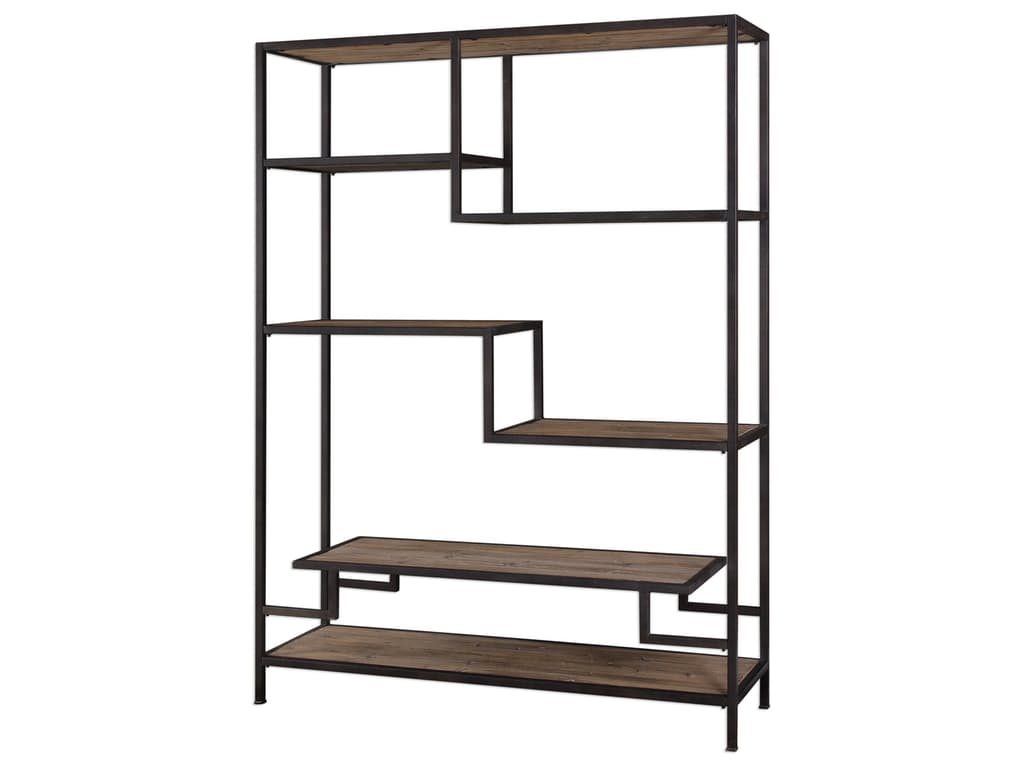
Uttermost Living Room Sherwin Industrial Etagere 24682
Tags: industrial design, industrial interior design, industrial interiors, industrial style, McCreerys, McCreerys Home Furnishings, modern industrial
Posted in Interior Design 101, Interior Design Themes | No Comments »
© McCreery's Home Furnishings | All Rights Reserved | Privacy Policy